Drag the images to arrange them by level of complexity from least to most complex, in order from left to right.
Tissue Level
Organ Level
Cellular Level
Organ system level
Chemical level

Which of the following is true regarding the anatomical position?
-It is a visual reference point only used in the various imaging techniques.
-The feet are placed at exactly 45 degrees outward.
-The person is seated with head facing forward.
-The palms face posteriorly with the thumbs pointed toward the body.
-Directional terminology refers to the body in this position.
Directional terminology refers to the body in this position.
Which of the following statements are accurate concerning light microscopy?
-It provides three-dimensional pictures of whole, unsectioned surfaces.
-It is limited because it cannot produce sharp images of structures within cells.
-It uses acidic and basic dyes to stain structures.
-Tissues are stained with heavy metal salts.
-It uses a beam of electrons to view cellular structures.
It is limited because it cannot produce sharp images of structures within cells.
Choose between chemical level, cellular level, tissue level, organ level, or organ system level.
- 1. Oxygen and hydrogen combine with one another to form water; this is an example of the ______________ of organization.
- 2. When many molecules come together to form organelles that become compartmentalized into a single structure that works as a unit, you have an example of the____________.
- 3. Muscle fibers are cells that contain actin, myosin, and other accessory proteins. When these cells are collected together, they can all function as a unit, carrying out the shortening capabilities of muscle. When multiple cells with a similar function come together, it is an example of the ___________.
- 4. The small intestine contains epithelial tissue, muscle tissue, and nervous tissue. The combination of these different tissue types to form one discrete structure is an example of the ___________.
- 5. The pituitary gland, adrenal gland, and other hormone-producing organs all work together to help the body send hormones through the blood stream and respond to internal changes. This is an example of the _____________
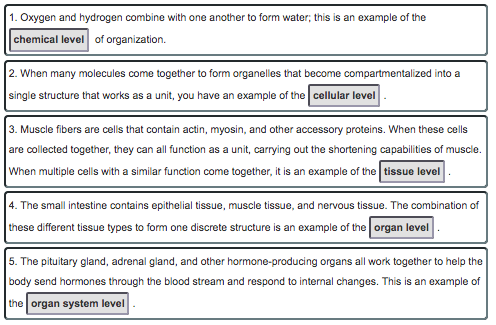
Which of the following best represents an example at the organ level?
-Smooth muscle in the large intestine
-Hydrochloric acid
-Digestive enzymes
-Stomach
-Enterocytes (cells that line the small intestine)
Stomach
The proximal convoluted tubule is a structure within the kidney nephron that plays a significant role in the reabsorption of important products that have been filtered from the blood. One of the key features of this structure is its lining. The cells that line the tubule are responsible for the transport of substances across the membrane. These cells and their collective efforts would be an example of which of the following levels?
-Tissue level
-Organ level
-Organismal level
-Molecular level
-Cellular level
Tissue level
Drag and drop each of the organizational levels so that they are in the correct order, ranking them from the simplest to the most complex.
chemical level, cellular level, tissue level, organ level, organ system level, or organismal level

Choose between organ level, chemical level, tissue level, cellular level, or organ system level.
- 1. _________ : Brain
- 2. _________ : Neurons
- 3. ___________ : Neurotransmitters
- 4. __________ : Neurons and neuroglial cells
- 5. ____________ : Brain combined with the spinal cord and spinal nerves
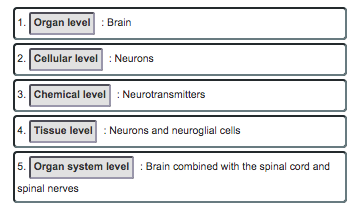
Choose between organ level, chemical level, tissue level, cellular level, or organ system level.
- 1. ______ level : Cardiac muscle, connective tissue, and endothelial cells all collecting together to form the human heart
- 2. ________ level : The tibia, which is made of connective tissue and nervous tissue
- 3. _________ level : A thin layer of cells that collectively form the lining of the lungs to allow for the diffusion of gases
- 4. ________ level : Golgi apparatus, mitochondria, and other organelles compartmentalized into a single structure by phospholipids, forming a single functional unit
- 5. _________ level : Carbon, hydrogen, and phosphate coming together to form the phospholipids of a cellular membrane
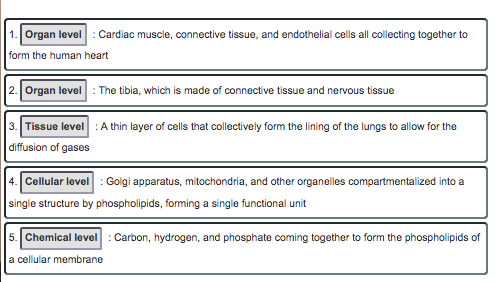
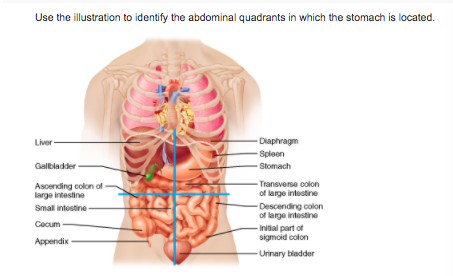
right upper quadrant and right lower quadrant
left upper quadrant and left lower quadrant
right upper quadrant and left upper quadrant
left lower quadrant and right lower quadrant
right upper quadrant and left upper quadrant
All vertebrates have specific identifying characteristics during some point of development. A partial listing of these characteristics is __________.
-ventral hollow nerve cord, radial symmetry, and tube-within-a-tube
-pharyngeal pouches, coronal symmetry, and anatomical position
-tube-within-a-tube, notochord, and ventral hollow nerve cord
-radial symmetry, vertebrae, and dorsal hollow notochord
-pharyngeal pouches, dorsal hollow nerve cord, and segmentation
pharyngeal pouches, dorsal hollow nerve cord, and segmentation
Bones lie __________ to muscles.
deep
What is the advantage of functional magnetic resonance imaging (fMRI) over positron emission tomography (PET)?
-fMRI uses sound waves rather than radioactive tracers.
-fMRI uses radioactive tracers rather than magnets.
-fMRI is better for determining the age of a fetus.
-fMRI is better for observing bones.fMRI pinpoints smaller brain areas, does not use radioactive tracers, and works faster.
fMRI pinpoints smaller brain areas, does not use radioactive tracers, and works faster.
Sonography is effectively used for viewing all of the following EXCEPT __________.
-arteries
-a developing fetus
-the gallbladder
-the brain and spinal cord
the brain and spinal cord
The right nostril and right ear are __________.
ipsilateral
The word __________ always refers to the part of the serosa that lines a body cavity.
parietal
The levels of structural organization in order of decreasing complexity are __________
-organ system, organism, organ, tissue, chemical, cellular
organ, organ system, tissue, cellular, molecular, atomic
-organism, organ system, organ, tissue, cellular, chemical
-chemical, cellular, tissue, organ, organ system, organism
-kingdom, phylum, class, order, family, genus, species
organism, organ system, organ, tissue, cellular, chemical
Cells, organelles, and tissues are usually measured in __________.
milliliters
micrometers
centimeters
meters
micrometers
Which set of orientation and directional terms is NOT correctly matched with its opposite?
contralateral: ipsilateral
proximal: distal
posterior: anterior
superficial: deep
distal: superior
distal: superior
Levels of Structural Organization
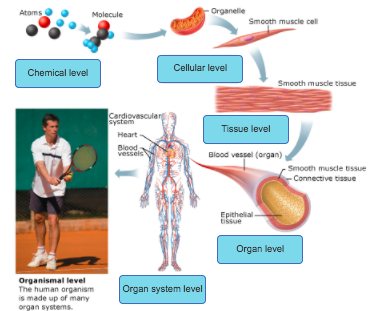
Dorsal and ventral body cavities and their subdivisions
cranial cavity, vertebral cavity, thoracic cavity, abdominal cavity, and pelvic cavity
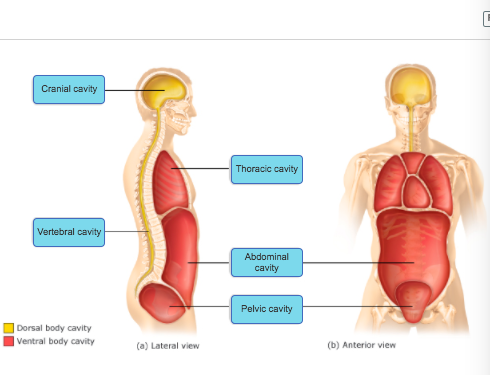
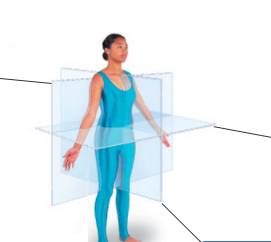
frontal plant, transverse plane and median plane

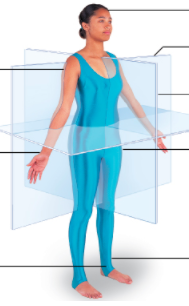
Superior
frontal plane
proximal
distal
inferior
median plane
medial
lateral
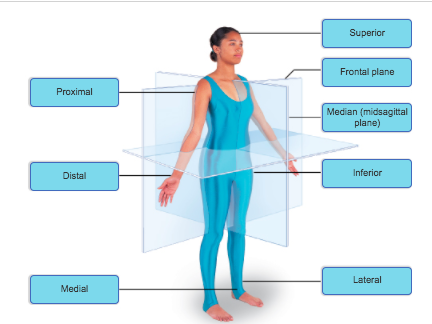
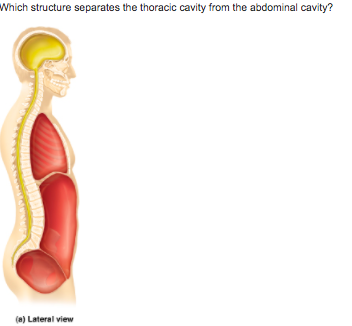
ventral body cavity
mediastinum
vertebral column
diaphragm
diaphragm
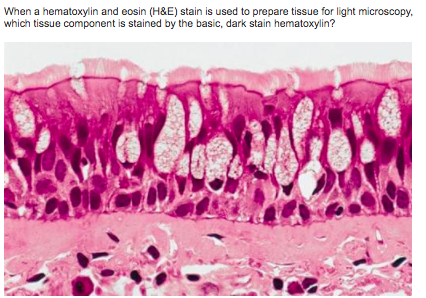
cilia
cellular cytoplasm
cellular nuclei
extracellular material
cellular nuclei
During the process of ________, noncellular artifacts can be introduced into histology samples.
-time
-observation
-staining
-photography
staining
The main purpose of fixation is
-to make an organ easier to section.
-to preserve the tissue.
-to stick tissue sections to a glass slide.
-to mend breaks in tissue sections.
to preserve the tissue.
What is the major difference in scanning electron microscopy (SEM) when compared to light microscopy (LM) or transmission electron microscopy (TEM)?
-SEM is not good at viewing higher magnifications.
-SEM uses whole, unsectioned surfaces that are covered in carbon and gold dust.
-SEM uses a beam of light to view specimens.
-The original image is in black and white.
SEM uses whole, unsectioned surfaces that are covered in carbon and gold dust.
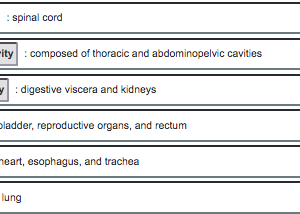
choose between vertral, ventral body, abdominal, pelvic, mediastinum, or pleural
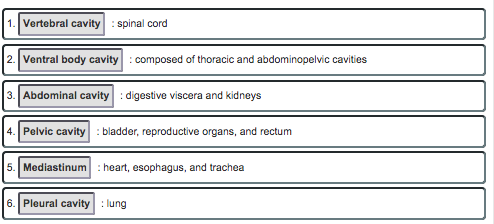
Patients with appendicitis often complain of abdominal pain in the right lower abdominopelvic quadrant. The appendix itself is in the__________.
-right lumbar region
-umbilical region
-hypogastric region
-right iliac region
right iliac region
The smallest living unit is
a human being.
an organ.
a cell.
a molecule.
a cell.
Which branch of anatomy studies the structural changes that occur as one ages?
regional anatomy
developmental anatomy
pathological anatomy
surface anatomy
developmental anatomy
A histologist examines a specimen that has an epithelium overlying some smooth muscle. This specimen is part of
a molecule.
an organ.
a tissue.
a cell.
an organ.
An example of a tissue in the body is
epithelium.
a muscle cell.
a macromolecule.
the stomach.
epithelium.
An example of an organ is
a fat cell.
epithelium.
the intestine.
the cardiovascular system (but not the circulatory system).
the intestine.
Large molecules such as proteins are called
macromolecules.
multi-atom units.
cells.
cellular organelles.
macromolecules.
The roots of anatomical terminology lie mainly in
Latin and Greek.
German and French.
Esperanto.
Russian and Old English.
Latin and Greek.
How many centimeters are there in a meter?
100
10
1,000,000
1,000
100
EM has much greater resolution than LM.
True
False
True
Most adults are between 1.5 and 2 meters tall.
True
False
true
The chest is ________ to the abdomen.
superior
lateral
anterior
proximal
deep
superior
The knee is ________ to the foot.
superior
lateral
anterior
proximal
deep
proximal
The brain is ________ to the skull.
superior
lateral
anterior
proximal
deep
deep
The thumb is ________ to the index finger.
superior
lateral
anterior
proximal
deep
lateral
Muscles are ________ to the skin.
superior
lateral
anterior
proximal
deep
deep
The eye is ________ to the occipital region.
superior
lateral
anterior
proximal
deep
anterior
The heart is ________ to the sternum.
superior
lateral
anterior
proximal
deep
deep
A coronal section through the human body can
-pass through both ears.
-provide mirror right and left images.
-lie in a horizontal plane.
-pass through both the nose and the occipital region.
-pass through both ears.
What is the function of serous membranes?
-They act like wrapping paper to hold visceral organs together.
-They halt the spread of infection.
-They contain gland cells that secrete mucus.
-They reduce friction so that viscera move freely.
-They reduce friction so that viscera move freely.
Which organ system covers the external surface of the body, but not the internal surface of the mouth?
-lymphatic
-cutaneous
-digestive
-integumentary
-integumentary
Which statement concerning the anatomical position is FALSE?
-The knees, elbow, and neck are straight (not bent).
-The person is lying down, as straight as possible.
-The palms face anteriorly.
-The toes point anteriorly, but the fingers point inferiorly
-The person is lying down, as straight as possible.
Bilateral symmetry can apply to objects as well as to animal bodies. Which of the following capital letters of the alphabet is not bilaterally symmetrical?
A
M
L
O
L
A frontal plane is the same as a ________ plane.
coronal
sagittal
transverse
midsagittal
coronal
Another name for the midsagittal plane is
oblique.
coronal.
parasagittal.
median.
median
Which of the following pairs of organs/structures is located ipsilateral?
mouth : navel
right lung : left lung
cecum : sigmoid colon
descending colon : spleen
descending colon : spleen
The ________ body cavity contains the brain.
ventral
dorsal
serous
lateral
dorsal
The ________ cavity contains the heart and lungs.
thoracic
dorsal
abdominopelvic
lateral
thoracic
Which structures are evidence of the vertebrate characteristic of segmentation?
branches of the blood vessels
multiple joints of fingers
subdivisions of the gastrointestinal tract
vertebral column
vertebral column
Which statement about visceral serosa is false?
-It clings to the surface of organs.
-It lines the internal surface of hollow organs.
-It is deep to the parietal serosa.
-It is continuous with the membrane that covers the outer body wall.
It lines the internal surface of hollow organs.
The ankle lies ________ to the thigh.
distal
proximal
lateral
inferior
distal
Serous cavities include the pleural cavity.
True
False
True
Serous cavities contain air.
True
False
False
In anatomical position, the palms of the hands face medially toward the thighs.
True
False
False
A transverse plane could cut the head off the body!
True
False
true
Hormones are regulatory proteins that are secreted by the ________ system.
integumentary
lymphatic
urinary
endocrine
endocrine
Which organ system keeps blood constantly supplied with oxygen, removes carbon dioxide, and contains many air tubes?
urinary
respiratory
endocrine
circulatory
respiratory
Someone studying anatomy using the systemic approach could study __________.
all the digestive organs
landmarks on the surface of the body
all the muscles, nerves, and blood vessels of individual areas of the body
changes in cells and tissues caused by disease
all the digestive organs
The words anatomy and dissection both derive from Greek word meaning __________.
functional morphology
cut apart
structure
landmark
cut apart
Pathological anatomy deals with structural changes caused by disease.
True
False
True
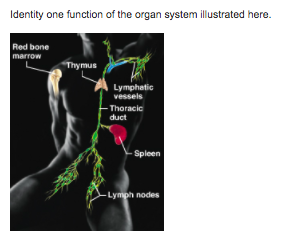
regulates water and electrolyte balance
delivers white blood cells to the body tissues
carries fluid from body tissues back to the blood vascular system
produces bile, which is used to break down ingested fats
carries fluid from body tissues back to the blood vascular system
Which system of the body eliminates nitrogenous wastes and regulates water, electrolyte, and acid-base balance of the blood?
urinary
lymphatic
digestive
cardiovascular
endocrine
urinary
Which organ system includes the spinal cord?
muscular
nervous
integumentary
skeletal
nervous